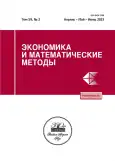Vol 59, No 2 (2023)
Articles
Аnalysis of marginalism. Part 1
Abstract
In recent years, based on the traditional theory of value — the labor theory of value and the theory of surplus value, as well as the hypothesis of Jevons, Tesla and Foley, — Chinese and Russian scholars have further adopted the mathematical paradigm of theoretical mechanics for reference to establish a mathematical model system for economics, which is called the new theory of value. Compatible with the traditional theory of value, the new theory of value puts forwardthat the value depends on the force of labor expended in the process of commodity production. While the value appreciation depends on the labor gravitational force generated by the improving dexterity of workmen. That is to say, during the process of production, constant capital and variable capital as kinetic energy and potential energy of value, convert into each other under the value conservation theorem, playing a dominate role in generating value and surplus value of products. In addition, the law of diminishing marginal utility is not an axiom, but a special economic law under unbalanced supply and demand. Obviously, these theoretical conclusions are of great significance, which not only make the traditional theory of value a self-consistent logical system, but also complete the new theory of value by absorbing the rational components from both the classical economics based on the labor theory of value and the theory of surplus value, and neoclassical economics based on the law of diminishing marginal utility. In this paper, we will analyze this problem by investigating the origin of the law of diminishing marginal utility.
 5-18
5-18


Recovering the actual trajectory of economic cycles
Abstract
The paper deals with the development of a method for restoring the trajectory of economic cycles from estimates of the gross domestic product (GDP). The proposed approach to solve this problem is based on the interpretation of cycles in the form of random oscillations of the income with a certain natural frequency, also called a narrowband random process. The operators (Fourier transforms, filtering, etc.) used to recover the cycle trajectory are linear. Their inherent associativity property allows changing the sequence of implementation of the linear operators above. As a result, it is proposed to start the recovery with bandpass filtering of the GDP function, and after that to parry the influence of the inertia property of the GDP estimator. Taking the qualities of a narrowband random process into consideration made it possible to create a simplified procedure to recover the cycle trajectory. In the example of the Kuznets swing, the acceptability of this procedure is demonstrated for the practical econometrics. The developed method is applicable in problems that require knowledge of the trajectory of the considered cycle.
 19-25
19-25


Optimization of structural dynamics of the economy in the framework of the “input-output” methodology
Abstract
 26-38
26-38


Modeling the socio-economic development of Russia using big data and data from field experiments
Abstract
 39-53
39-53


Impact of the COVID-19 pandemic on the socio-economic development of the region
Abstract
 54-67
54-67


Rationing and market: Structure and stability of equilibria
Abstract
 68-86
68-86


Computer testing of a non-parametric partial equilibrium model prototype
Abstract
 100-111
100-111


Optimal solution for immunizing arbitrarily scheduled multiple liabilities
Abstract
 87-99
87-99


Issues of balancing economic growth and the state of the environment
Abstract
 112-121
112-121


On simplification of the transport problem solution with ecological criterion
Abstract
 122-127
122-127


 128-130
128-130


 131-132
131-132











